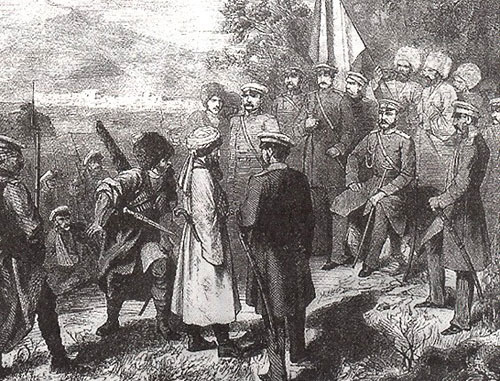Caucasian War
Background
In the last third of the 18th-start of the 19th century, the Russian Empire conquered the territory of the Greater and Lesser Kabarda. The Bucharest Peace Treaty with the Ottoman Empire (1812) fixed the Russia's possession of Western Georgia and protectorate over Abkhazia. Under the Gulistan Peace Treaty with Iran (1813), Dagestan, Kartli-Kakheti, Karabakh, and the Shirvan, Baku and Derbent Khanates occurred under Russia's control. The south-western part of Northern Caucasus remained in the sphere of influence of the Ottoman Empire. The mountainous regions of Northern and Central Dagestan and Southern Chechnya remained outside Russia's control.
First stage – General Ermolov's actions and rebellion in Chechnya (1817-1827)
In May 1816, General Alexander P. Ermolov was appointed to the post of the Commander of a Separate Georgian (later – Caucasus) Corps, and Russia embarked on a systematic conquest of the region.
In 1818, the Nizhne-Sunzha line and the Nazran redoubt (modern Nazran) were reinforced in Ingushetia; and the Fortress Groznaya (modern Grozny) was built in Chechnya. Russian fortresses were in construction on the Malka, Baksant, Chegem, Nalchik and Terek Rivers, which formed the Kabarda line.
In 1822, the independence of Kabarda and its dependent tribes was finally eliminated; and Kumyks' lands were conquered. Russian troops began advancing deep into the foothills of the Greater Caucasus Mountain Range, away from Terek and Sunzha, burning down the "militant" auls (villages) and felling dense forests (especially in Southern Chechnya). The highlanders' resistance was suppressed by Ermolov's punitive expeditions.
The General's actions provoked a general uprising of Chechen highlanders (1825-1826) under command of Bey-Bulat Taimiev (Taimazov), which was suppressed.
Second stage – formation of Imamate of Nagorno-Dagestan and Chechnya (1828-early 1840s)
In 1827, Ermolov was replaced by Adjutant General Ivan F. Paskevich. In the 1830s, the Lezgin cordon line was built in Dagestan; and in 1832, the fortress Temir-Khan-Shura (modern Buynaksk) was built.
The Mountainous Dagestan became the main focus of resistance; it was united under the rule of the military-theocratic Muslim state – the Imamate, established in 1828 or 1829 by Ghazi Mohammed, an Avar national from Gimry, who sought to unite the mountaineers of Chechnya and Dagestan for waging a jihad against Russians. Ghazi Mohammed's tactics was to undertake rapid and unexpected raids.
In 1830, he captured a number of Avar and Kumyk villages subservient to the Avar Khanate and the Tarkovsky Shamkhalate. Untsukul and Gumbet joined the Imamate voluntarily; while the Andis were subdued. In the same year, Ghazi Muhammad tried unsuccessfully to capture the village of Khunzakh, the capital of Avar khans, who took the Russian allegiance.
In 1831, Ghazi Muhammad plundered Kizlyar; and on the following year he besieged Derbent. In March 1832, the Imam came to Vladikavkaz and besieged Nazran, but was defeated. The new Commander of the Caucasus Corps – Adjutant General Baron Grigory V. Rosen (1831-1837) –defeated the army of Ghazi Muhammad and took his native village of Gimry. The first Imam fell in the battle.
The second Imam was an Avar Gamzat-bek (1833-1834). After his death, Shamil became the third Imam, who completed the formation process of the state order of the Imamate.
Third stage – spread of Imamate power over Mountain Circassia and Vorontsov's activities in the Caucasus (1840-early 1850s)
Under the Adrianople Peace Treaty that ended the 1828-1829 Russian-Turkish war, Russia obtained the fortresses of Anapa, Poti and Akhaltsikh; while Turkey renounced its claims for the territories of Trans-Kuban (the current Krasnodar Territory and Adygea).
In summer of 1830, as a result of the punitive expedition of General Abkhazov against Ingushes and Tagauris, Ossetia was finally included into Russia.
In 1837-1839, in order to stop imports of strategic materials to Circassians of Western Caucasus, the Russian Command established the Black Sea Coastline. In early 1840s, Coastline was swept away by a large-scale offensive of Circassians-Shapsugs, Natukhai and Ubykh nationals, but by November it was restored.
In the 1840s-the first half of the 1850s, Imam Shamil tried to unite with the Circassians of the Northwest Caucasus. In spring of 1846, Shamil launched a campaign into Western Circassia; however, he received no support and retreated to Chechnya.
In late 1848, Mohammed-Amin, Shamil's Naib, appeared in Circassia. He created a unified administration system in Abadzekhia. Since the beginning of 1850 and until May 1851 he submitted Bzhedugs, Shapsugs, Natukhais, Ubykhs and several smaller Circassian tribes. The Naib had the territory between the Kuban and Laba Rivers and the Black Sea under his rule.
In 1845, Count Mikhail S. Vorontsov (1844-1854) became a new Chief Commander of the Caucasus. He stepped up military operations in mountainous areas, controlled by the Imamate. Russian troops invaded Northern Dagestan, and seized and destroyed Shamil's residence in the village of Dargo. In 1848, the army seized the village of Gergebil. Shamil's units resumed operations to the south of the Lezgin lines, and in 1848 unsuccessfully attacked Russian fortifications in the Lezgin village of Akhty. In 1852, Adjutant-General Prince Alexander I. Baryatinsky, a new commander of the left flank, knocked highlanders out of a number of strategically important villages of Chechnya.
Fourth stage – end of Caucasian War in North-Eastern Caucasus. Crimean War and Baryatinsky's conquest of Chechnya and Dagestan (1853-1859)
In the context of the start of the Crimean War (1853-1856) in the North-East Caucasus, Shamil tried to unite with the Turkish forces in Transcaucasia. In June 1854, a detachment under command of Shamil invaded Georgia, but under the pressure of Russian troops retreated to Dagestan.
After the Crimean War, the Caucasian Corps of the new Chief Commander Prince Baryatinsky (1856-1862) was reinforced by fresh troops. Highlanders grew tired of the war; the war-ravaged rural communities began to surrender to Russian military authorities. In the Northwest Caucasus, internal disagreements and conflicts – in particular, among supporters of Muhammed-Amin and Sefer-bey Zan – seriously complicate the position of Circassians.
In 1856-1857, detachments of General Nikolai I. Evdokimov knocked Shamil out of Chechnya. In April 1859, the new residence of the Imam – the village of Vedeno was captured by storm. On September 6, 1859, Shamil surrendered. The war was over in North-East Caucasus.
Final stage – conquest of Northwest Caucasus (1859-1864)
At this stage (1859-1864) military actions were especially cruel. The regular army was opposed by scattered units of Adygs, who fought in remote mountainous areas of Northwest Caucasus. Circassian villages were burned down in hundreds.
In November 1859, Imam Mohammed-Amin admitted his defeat and swore allegiance to Russia. In December of the same year, Sefer-bey Zan died suddenly. In 1860, Natukhais stopped their resistance, but Abadzekhs, Shapsugs and Ubykhs continued their struggle for independence.
In June 1861, representatives of these nations gathered for a general meeting in Sochi Valley and established the supreme authority of Cherkessia (Circassia) – the Majlis. The united government sought international recognition and tried to negotiate with the Russian command on the terms of ending the war. But Russian leaders rejected the proposals of the Majlis. Circassians were given a choice – surrender and resettlement to the plains, or deportation to Turkey, or extermination. Most Circassians migrated to Turkey.
On May 21, 1864, in the town of Kbaada (Krasnaya Polyana), in the upper section of the Mzymta River, a solemn prayer service and a parade of troops marked the end of the Caucasian War and approval of Russian domination in Western Caucasus.







![Tumso Abdurakhmanov. Screenshot from video posted by Abu-Saddam Shishani [LIVE] http://www.youtube.com/watch?v=mIR3s7AB0Uw Tumso Abdurakhmanov. Screenshot from video posted by Abu-Saddam Shishani [LIVE] http://www.youtube.com/watch?v=mIR3s7AB0Uw](/system/uploads/article_image/image/0001/18460/main_image_Tumso.jpg)